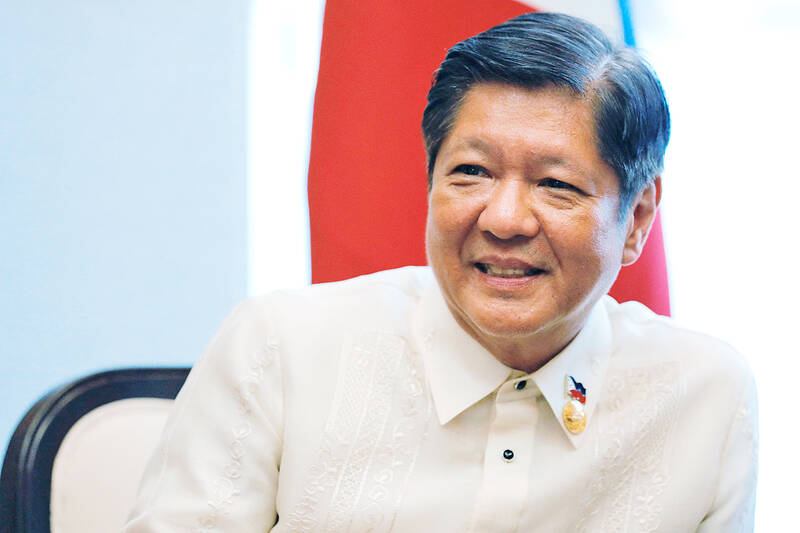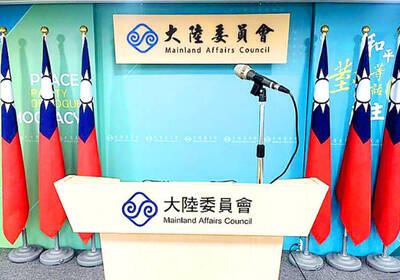The Philippine government would take back control, if needed, of the company that runs the nation’s power transmission network partly owned by State Grid Corp of China (國家電網), Philippine President Ferdinand Marcos Jr’s office said.
Marcos met with Philippine Senator Raffy Tulfo who heads a committee investigating the situation at National Grid Corp of the Philippines (NGCP) following recent incidents of power outages in the Southeast Asian country.
Marcos backed Tulfo’s proposal to “conduct a comprehensive study or hold hearings,” Marcos’ communications office said in a statement posted on its Facebook page on Wednesday.

Photo: Reuters
Tulfo “aimed to examine the security aspect, particularly on who truly controls the corporation,” the statement said.
“If necessary, the government will take back control of the entity,” it said.
China’s State Grid has a 40 percent stake in NGCP after winning, with other investors, a 25-year concession to run the Southeast Asian country’s power transmission network in 2007.
The remaining 60 percent is held by Philippine investors including Synergy Grid & Development Phils Inc president Henry Sy Jr and Prudential Guarantee & Assurance Inc chairman Robert Coyiuto Jr.
Chinese Ministry of Foreign Affairs spokesman Wang Wenbin (汪文斌) did not directly respond to a question on the Philippines’ plans when asked during a regular briefing in Beijing.
“China supports Chinese companies in expanding cooperation with the Philippine side and achieving mutually beneficial results,” Wang said, adding that Manila is a “friendly partner” of Beijing.
Previous efforts by officials for the government to reclaim control of power grid operations did not prosper and the Philippine Department of Energy has proposed to amend a 2001 law to ban foreign-owned or foreign government-backed enterprises from engaging in power transmission.
At a hearing of the energy committee on Wednesday, Philippine Senator Risa Hontiveros said they might need to scrutinize “not just China’s control of NGCP, but the performance of the company itself,” adding that “this time we might need to see if we have to revoke its franchise.”
NGCP is “ready to answer any and all questions raised concerning how we do business,” company spokesperson Cynthia Alabanza said, adding that the firm had invested 300 billion pesos (US$5.38 billion) to strengthen the transmission system.
Separately, Australian Minister for Foreign Affairs Penny Wong (黃英賢) said her country would provide surveillance drones and other high-tech gear to the Philippine Coast Guard and is considering whether to take part in joint patrols in the disputed South China Sea.
Wong, who held talks in Manila with Philippine Secretary of Foreign Affairs Enrique Manalo, also thanked the Philippine government for its help in the discovery of a ship that sank during World War II in the northern Philippines, killing nearly 1,000 Australians “in a very sad chapter in our history.”
The US and the Philippines, which are longtime treaty allies, have been holding talks on proposed joint naval patrols in the South China Sea, where China has fortified its vast territorial claims by transforming disputed reefs into missile-protected island bases and deploying Chinese Coast Guard and militia ships on constant patrols.
Aside from China and the Philippines, Taiwan, Vietnam, Malaysia and Brunei are also embroiled in the territorial disputes.
Additional reporting by AP

SEPARATE: The MAC rebutted Beijing’s claim that Taiwan is China’s province, asserting that UN Resolution 2758 neither mentions Taiwan nor grants the PRC authority over it The “status quo” of democratic Taiwan and autocratic China not belonging to each other has long been recognized by the international community, the Mainland Affairs Council (MAC) said yesterday in its rebuttal of Beijing’s claim that Taiwan can only be represented in the UN as “Taiwan, Province of China.” Chinese Minister of Foreign Affairs Wang Yi (王毅) yesterday at a news conference of the third session at the 14th National People’s Congress said that Taiwan can only be referred to as “Taiwan, Province of China” at the UN. Taiwan is an inseparable part of Chinese territory, which is not only history but

CROSSED A LINE: While entertainers working in China have made pro-China statements before, this time it seriously affected the nation’s security and interests, a source said The Mainland Affairs Council (MAC) late on Saturday night condemned the comments of Taiwanese entertainers who reposted Chinese statements denigrating Taiwan’s sovereignty. The nation’s cross-strait affairs authority issued the statement after several Taiwanese entertainers, including Patty Hou (侯佩岑), Ouyang Nana (歐陽娜娜) and Michelle Chen (陳妍希), on Friday and Saturday shared on their respective Sina Weibo (微博) accounts a post by state broadcaster China Central Television. The post showed an image of a map of Taiwan along with the five stars of the Chinese flag, and the message: “Taiwan is never a country. It never was and never will be.” The post followed remarks

INVESTMENT WATCH: The US activity would not affect the firm’s investment in Taiwan, where 11 production lines would likely be completed this year, C.C. Wei said Investments by Taiwan Semiconductor Manufacturing Co (TSMC, 台積電) in the US should not be a cause for concern, but rather seen as the moment that the company and Taiwan stepped into the global spotlight, President William Lai (賴清德) told a news conference at the Presidential Office in Taipei yesterday alongside TSMC chairman and chief executive officer C.C. Wei (魏哲家). Wei and US President Donald Trump in Washington on Monday announced plans to invest US$100 billion in the US to build three advanced foundries, two packaging plants, and a research and development center, after Trump threatened to slap tariffs on chips made

CONSISTENT COMMITMENT: The American Institute in Taiwan director said that the US would expand investment and trade relationships to make both nations more prosperous The US would not abandon its commitment to Taiwan, and would make Taiwan safer, stronger and more prosperous, American Institute in Taiwan Director Raymond Greene said. “The US’ commitment to Taiwan has been consistent over many administrations and over many years, and we will not abandon our commitment to Taiwan, including our opposition to any attempt to use force or coercion to change Taiwan’s status,” he said in an exclusive interview with the Liberty Times (the sister newspaper of the Taipei Times) on Friday last week, which was published in the Chinese-language newspaper yesterday. The US would double down on its efforts